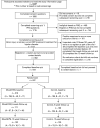Randomized controlled trial of computerized cognitive behavioural therapy for depressive symptoms: effectiveness and costs of a workplace intervention
- PMID: 23795621
- PMCID: PMC3898729
- DOI: 10.1017/S0033291713001323
Randomized controlled trial of computerized cognitive behavioural therapy for depressive symptoms: effectiveness and costs of a workplace intervention
Abstract
Background: Depression and anxiety are major causes of absence from work and underperformance in the workplace. Cognitive behavioural therapy (CBT) can be effective in treating such problems and online versions offer many practical advantages. The aim of the study was to investigate the effectiveness of a computerized CBT intervention (MoodGYM) in a workplace context.
Method: The study was a phase III two-arm, parallel randomized controlled trial whose main outcome was total score on the Work and Social Adjustment Scale (WSAS). Depression, anxiety, psychological functioning, costs and acceptability of the online process were also measured. Most data were collected online for 637 participants at baseline, 359 at 6 weeks marking the end of the intervention and 251 participants at 12 weeks post-baseline.
Results: In both experimental and control groups depression scores improved over 6 weeks but attrition was high. There was no evidence for a difference in the average treatment effect of MoodGYM on the WSAS, nor for a difference in any of the secondary outcomes.
Conclusions: This study found no evidence that MoodGYM was superior to informational websites in terms of psychological outcomes or service use, although improvement to subthreshold levels of depression was seen in nearly half the patients in both groups.
Figures


References
-
- ANU (2012). MoodGYM: Welcome (https://://moodgym.anu.edu.au/welcome). Australia National University; Accessed 3 December 2012
-
- Beecham J, Knapp M (2001). Costing psychiatric interventions In Measuring Mental Health Needs, 2nd edn (ed. Thornicroft G.), pp. 200–224 Royal College of Psychiatrists: London
-
- Brooks RG, Jendteg S, Lindgren B, Persson U, Björk S (1991). EuroQol: health-related quality of life measurement. Results of the Swedish questionnaire exercise. Health Policy 18, 37–48 - PubMed
-
- Christensen H, Griffiths KM, Mackinnon AJ, Brittliffe K (2006). Online randomized controlled trial of brief and full cognitive behaviour therapy for depression. Psychological Medicine 36, 1737–1746 - PubMed
Publication types
MeSH terms
Grants and funding
LinkOut - more resources
Full Text Sources
Other Literature Sources
Medical

